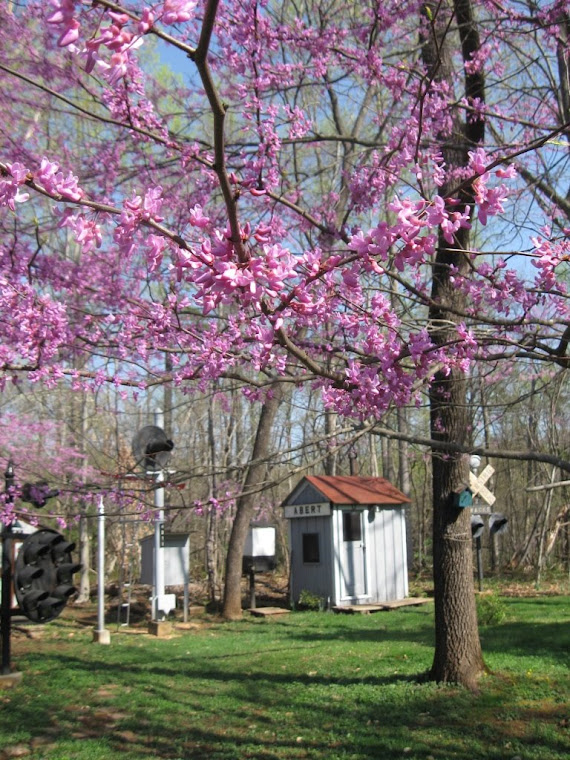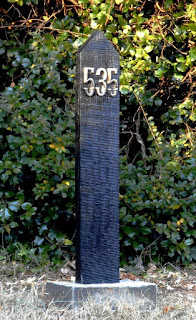N&W PL-4 Dwarf Signal
This Norfolk & Western Railway US&S dwarf signal is the first addition to the "Wiley Railroad Relic Garden" in 2015. This Union Switch & Signal Co. model was first introduced in 1930 and was called a PL-4, "New" model. Dwarf signals were used in railroad yards, as well as to govern certain side tracks and they were far fewer in number than regular, tall signals.
Signals on the old Norfolk & Western were called "Position Light" signals, meaning the arrangement of the amber lights would display the indication or aspect. All horizontal meant stop; all angled meant a cautionary clear and all vertical meant a clear signal. There were exceptions to these indications explained in detail in the railroad's rule book. In the late 1950's, N&W started to change from the pure, position light signals to a modification, using colors as well (red, amber and green). This system was called "Color Position Light." In the early 1960's, N&W started to operate with this new style for its dwarf signals and this is how my dwarf signal is configured. The signal aspects were as follows.
Green over Red - Rule 287, Slow Clear
Yellow over Red – Rule 288, Slow Approach
Red beside Red - Rule 292, Stop and Stay
When used by the N&W, it is likely that this dwarf signal was located at HQ Tower, Bluefield, Virginia (milepost 357) to govern train movements against the normal flow of traffic at the faceing point crossover between the mainline tracks there. During it's years of service, tens of thousands of freight trains passed by.
The back is removed, revealing the inside of the signal.
This link is to a 12 second video of the signal illustrating all of its aspects (indications).
https://www.youtube.com/watch?v=oxyZoBYrYTc
N&W Bridge Number Post


In November 2016 while visiting remaining railroad locations in West Virginia of Norfolk & Western's Bluestone Branch, I noticed a new-to-me relic at Matoaka, a concrete post near the end of the railroad bridge over Left Fork of Widemouth Creek. The weathered post shows the number 2309, which, as I found, is the number of the bridge on N&W track charts. After describing this unusual post with many friends, it seems it likely dates to when this branch was built soon after the turn of the century. I found no reference at all to a bridge number post in the archives of N&W Historical Society. I have learned from my friends that another bridge number post stands at Montcalm, also on the Bluestone Branch. It seems that these tow posts are the sole survivors. By the way, N&W abandoned most of the branchline in place in 1984. Unable to find any material whatsoever in the N&W archives, I have made a rough, not to scale drawing, showing measurements made during examination of the post at Matoaka. (42" above ground, 10" wide and 4" thick) This photo shows the bridge number post situated 12 feet from the center of the track at Weyanoke, WV.
~ ~ ~ ~ ~
Inspired by this unusual find, I decided a make a replica of it for our Wiley Railroad Relic Garden. In addition to providing a source for others to study, it serves a useful purpose. I put it at the end of our driveway and it shows the house number on one side and the number on the back is the number of the post that inspired me, number 2309.
Assistance was given by Jon Charles, Jeff Hawkins and Ken Miller.
Chesapeake & Ohio RailwayStation Scales from Mount Hope, W V
This Fairbanks Company station scales was a recent gift from a friend in West Virginia. Having a capacity of half a ton, the scales were last used at Mount Hope on C&O's Loop Creek Branch which extended twelve miles south from the mainline at Thurmond, WV on the New River.
One rail historian wrote, "Any station that handled express would need one of these as billing depends on weight and dimension. I am sure the possibility of weighing LCL (less than carload) items and passenger baggage (trunks, etc) would factor in. C&O had a calibration and repair shop at Huntington that handled these system wide and scales rotated from place to place as they were out shopped." The scales' deck is 17-1/2" by 26-1/2" and the balancing tower reaches 45 inches.
One rail historian wrote, "Any station that handled express would need one of these as billing depends on weight and dimension. I am sure the possibility of weighing LCL (less than carload) items and passenger baggage (trunks, etc) would factor in. C&O had a calibration and repair shop at Huntington that handled these system wide and scales rotated from place to place as they were out shopped." The scales' deck is 17-1/2" by 26-1/2" and the balancing tower reaches 45 inches.
The 1948 Official Guide for Passenger Trains shows that passenger train service was still available at Mount Hope in 1948. It lists passenger train number 136 leaving the mainline at Turmond at 3:10 pm, making the twelve mile journey up the mountains to Mount Hope, arriving at 4:05 pm. The return train, number 137, left Mount Hope at 4;20, reaching Thurmond at 5:03 pm. Virginian Railway had branchline passenger and freight service to some of the same line as C&O, but it did not reach Mount Hope. Its closest point was Oak Hill, WV.
An inspection date stenciled on the scales is March 1948 and it was performed on site by a C&O railroad inspector.














